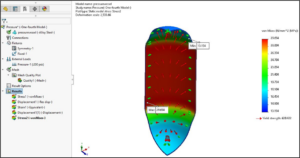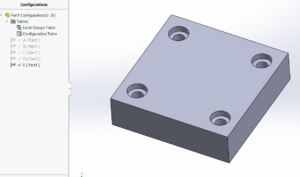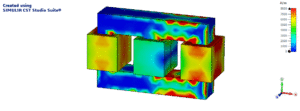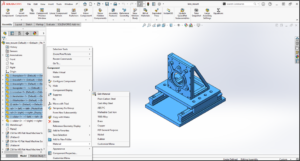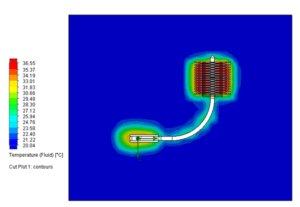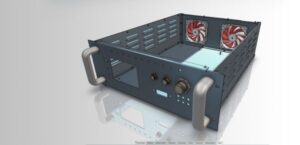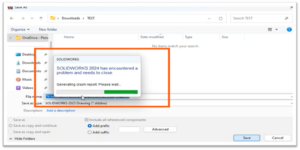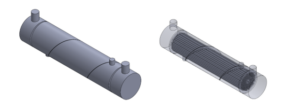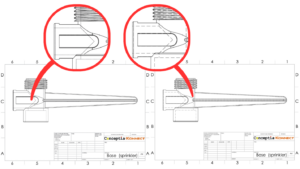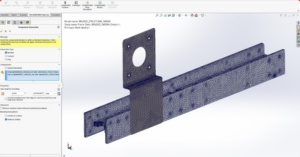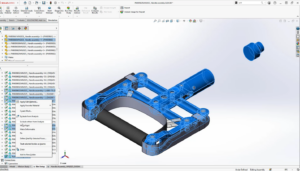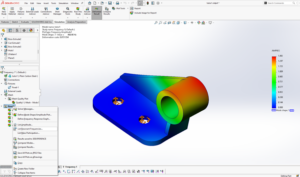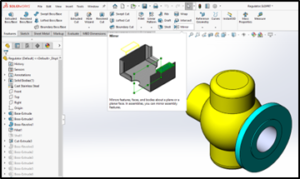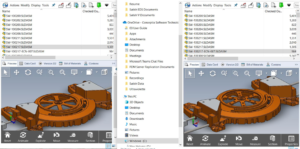Probably the greatest inventor of all time Thomas Alva Edison has shaped product development to this day through his way of working.
For his well-known invention of the mass-suitable incandescent lamp, he and his employees carried out elaborate and costly test series in the laboratory. After 1.5 years, a result could be presented with groundbreaking success. Edison’s guiding principle was: even a failure is a step towards the solution.
By using modern simulation tools, this empirical approach can be transferred from the workshop to the virtual world of the computer, making it more efficient. Thomas Alva Edison would have loved it.
Over the years, some trends in simulation have emerged. SOLIDWORKS is always up to date with its simulation tools SOLIDWORKS Simulation, SOLIDWORKS Flow Simulation and SOLIDWORKS Plastics. Below you will read about these developments.
Trend 1: Simulation changes the work of the expert
In all occupational fields in which the simulation is introduced, the task of the experts working there changes. Traditionally, the expert is the decider. He sets the direction and defines the next steps. Of course, this task is often split over several shoulders. This path is then put into action by using not insignificant resources. The success of the measure can only be determined at the end. If possible, changes can be added later and this route can be guided to the destination in further iteration loops.
By using a simulation tool, the task of the expert is now changing. This no longer sets the path, but defines the boundary conditions necessary for a successful approach. Then all possible ways are simulated, ie calculated by the computer. Prerequisite is a mathematical model, which describes the facts sufficiently accurately. The expert can now choose the most successful way out of the results and put them into action. The resources are now used directly to achieve the goals. This not only saves time, but also money.
This is clear from two examples. In the election campaign, the parties or the top candidates resort to election campaign experts. So far, these experts evaluated the available survey and opinion research results and derived a strategy from them. On election night, the success of this strategy showed. In this case, a course correction is no longer possible.
In the 2012 US election campaign, Barack Obama’s campaign focused on the simulation. The electoral experts created a mathematical model that described the change voter. Then they defined the boundary conditions for about 100 parameters. From the results of the simulation, the most successful strategy for the individual groups of voters could be derived. The result spoke for the Obama campaign. The decisive change voters could be won.
A concrete example of mechanical engineering is product development. Traditionally, much work is done here with prototypes. The designer as an expert defines the design. Here also the circle closes again to Thomas Alva Edison. Using time and money, the sophisticated product is developed in several iteration loops. This procedure is also used in special machine construction. Only here is the mature prototype finally sold.
By using a simulation tool, product development can be carried out more efficiently. The designer continues to create his parametric 3D model in SOLIDWORKS. Now, however, he sets the decisive parameters as variables and specifies a logical value range. The simulation now calculates all possible scenarios and lists the results clearly. In the strength calculation of SOLIDWORKS Simulation, this function is called design study (see Figure 1). In the flow simulation of SOLIDWORKS Flow Simulation Parametric studies can be used to carry out such statistical test evaluations. The designer can then derive the correct parameters from the results and thus release the optimal design of the production.

Figure 1: Design study in SOLIDWORKS Simulation
Trend 2: Emphasis on easy operation
Another trend in simulation is that the application shifts from the dark basements of the computational specialists to the sacred halls of construction. The validation is done directly by the designer. The advantage of this approach is that the designer knows very well about the location and the boundary conditions of the construction. It eliminates the interface to the calculation engineer. This saves time and eliminates the error source of incorrect results due to communication errors.

Figure 2: SOLIDWORKS 2007 with COSMOS Works
Prerequisite, however, is a simple and intuitive user interface. SOLIDWORK recognized this trend very early. Already in 2001 COSMOS Works integrated the designaccompanying simulation into the CAD (see Figure 2). This integration has been further improved over the years and the user interface has been further simplified. With SOLIDWORKS Simulation and SOLIDWORKS Flow Simulation Today, it goes without saying that material properties, plate thicknesses and welding distances are automatically taken into account in the simulation. The boundary conditions, such as loads, contacts, power losses, volume flows, etc., can already be predefined in the individual part or subassembly. If the designer now uses these components to assemble the entire assembly, these constraints can be imported directly. The simulation is now done at the touch of a button.
Technologies that were previously reserved for the simulation specialists are finding their way into the design departments more and more. With the SOLIDWORKS topology study, for example, the designer has an easy way to optimize his designs. A kind of artificial intelligence finds the geometry with the best ratio of weight and rigidity for the available space and the given load cases. Because this is done directly in SOLIDWORKS, the geometry can be reused without being imported in the design (see Figure 3).

Figure 3: SOLIDWORKS topology study
The design-accompanying calculation makes it possible to test and optimize the functionality of the module at a very early point in time. Vulnerabilities can be fixed without much effort. The design starts with the optimal design and thus delivers the best end product.
Trend 3: Versatile calculation options
Finally, further development in the field of simulation has to be considered. With continuous development of the equation solver and simultaneous multiplication of the computing power also the simulation possibilities increased. Due to the increase in available memory, due among other things to the 64-bit technology, ever larger networks could be calculated. By improving the processors and parallelizing them to multiple cores, the computation speeds could be significantly reduced.
Initially, COSMOS Works in 2001 almost exclusively single parts or simple contact problems were calculated. The results had to wait several hours. Today, item calculations are completed in seconds. With the increased possibilities but also the claims increased. It has become obvious that whole assemblies are simulated. In these calculations, a variety of different contacts and fasteners are taken into account. Thus, the calculation time is still several hours, however, the validity of the results by far greater.
In addition to the hardware, the Solver itself has also undergone constant development. At the beginning of COSMOS Works Solvers a mathematical model for static-linear strength calculations was implemented. Over time, functionality has been extended to include thermal, non-linear and dynamic computing capabilities. In addition, additional applications have been developed for SOLIDWORKS. With SOLIDWORKS Flow Simulation a three-dimensional flow simulation has been integrated. EM Works extends the simulation possibilities with electro-magnetic calculations. For example, magnetic field strengths or eddy currents can be calculated directly in the CAD model. The motion simulation industrial physics allows virtual commissioning of entire SOLIDWORKS plant models
However, not only are new solvers developed and integrated, but the existing equation solvers are increasingly linked together. Already today, it is possible to use SOLIDWORKS Flow Simulation to calculate calculated pressure or temperature loads in a strength calculation (see Figure 4). Similarly, calculated magnetic field forces from EM Works can be included in a motion analysis. This multiplies the areas of application of the simulation again.

Figure 4: Multiphysics simulation with SOLIDWORKS simulation and flow simulation
Conclusion
The last few years have shown that the simulation tools have developed rapidly. Because there are suitable solutions for the most diverse tasks. These solutions are available through the improved ease of use for everyone. This development will certainly intensify in the coming years. In many areas, simulation has become indispensable even today. Therefore, the importance of simulation tools will continue to increase in the future.
The development of intelligent computer systems will continue to change the simulation. It will become a central component, especially in product development. The CAD system will independently provide design recommendations for given design tasks. Previous design experience, measurement data from current products and varied simulations are linked to optimal products.

